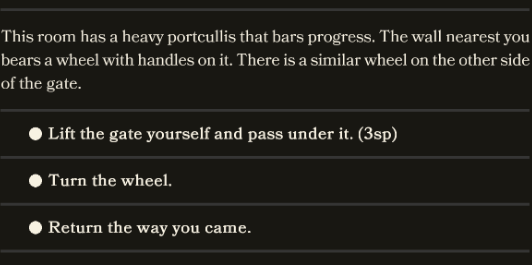Gates, Keys, and Luck

Dead Ends
Humans don't create dead ends. Walk around any modern building and what you reach are fire exits, offices, cupboards, and toilets. We make destinations instead of dead ends. In most roguelikes we ignore the meaningless dead end, but in a narrative they have to mean something. So I made my life easier by removing them - the dungeon is now made of loops.
Gates and Keys
Every item in every game is usually a key, or enables the user enough to be the key themselves. For every key there must be a gate. So I'm forced to add two new decks of rooms: gates and keys. The gates in this version are soft-gates that can be overcome with enough stamina, future gates may demand an item for passage.
Luck Points
I felt like I needed another stat apart from stamina. Michael Brough seems to go for 2 stats all the time, usually so he can offload issues with the main stat on to the second and vice versa. Old Fighting Fantasy books gave you stamina and luck, the latter used to modify dice rolls. Luck sounded a good fit for kobolds, but how would I use it and how would I show it to the player? What if I didn't show it? And like that, everything fell into place.
The dungeon previously had a flat difficulty - the first room as deadly as the last. But with a reserve of luck to spend on entering a nicer version of a room, we get depth. Each room runs in a loop. If a player has luck points I can shunt them on to an easier loop - an easier version of the same room. This takes the edge off the opening rooms. By not showing how luck is spent, but telling you it's there and dropping hints, I solve another problem: meaning. A coworker complained the ghost room felt like a waste of time, that he should at get some small benefit from talking to it. You want meaning? Fine. Now everything has meaning, everything is possibly a luck spend or luck gain - this anxiety fits kobolds well. Hopefully it will make the game more fun for people who only care for numbers.
The Empty Room
The next update requires a very special room. I had in mind a novelty room that would appear in several places in the dungeon. Copy-pasted several times. The in-game explanation is that it is padding - the dungeon designer has used magic to save time and make the dungeon look bigger. Every time you enter the room you're in the same loop, marveling at the magic and frowning at how cheap it is.
This room is the main quest. It will be the most visited room and as such will allow me to tell the story of who the player is and what their world is like. I prefer this to a lengthy downtime story in-between dungeon runs. This means that your identity is explored inside the dungeon and can have an impact on your survival.
Lots to do....
Aside from more UI work I've a lot of text adventure mini games to write. Hopefully they will be fun to play.
Get Kobold Dungeon Tester
Kobold Dungeon Tester
A multiple-choice-adventure-roguelike about testing a dungeon.
| Status | On hold |
| Author | st33d |
| Genre | Interactive Fiction |
| Tags | Dungeon Crawler, inkle, Roguelike, Roguelite, Text based |
More posts
- ShelvedDec 16, 2019
- Redraft 3: WisdomOct 30, 2019
- DesktopJun 10, 2019
- A Lick of PaintJun 06, 2019
- GoldJan 29, 2019
- Death and RebirthDec 20, 2018
- Android BuildOct 20, 2018
Leave a comment
Log in with itch.io to leave a comment.